by Yolanda Goode | Feb 27, 2015

My Heart to Greater Loyalty…
A handwritten note or card can express one’s gratitude, thankfulness, care, or encouragement and has not gone extinct even in this age of technology. Just think about the last time you received a personal handwritten note from someone. You may have gotten emails, texts, or posts relating to the same event and you appreciated it all but isn’t there just something a little extra special about receiving a written note?
Florida 4-H helps youth develop life skills. Life skills are those competencies (measurable or observable knowledge, skills, abilities, and behaviors) that assist people in functioning well in the environments in which they live. Life skills are transferable which makes them different from task specific skills like tying a bow or knot.
In February we think of all things related to the heart due to Valentine’s Day. The second H in 4-H stands for the Heart. Looking at Targeting Life Skills in 4-H, the Heart has two life skills subcategories; caring and relating. The specific life skills under caring are empathy, sharing, nurturing relationships, and concern for others. Youth need an opportunity to demonstrate these skills throughout the year.
This takes us back to the handwritten note and your call to action to cultivate the art of note writing in our youth and give them another outlet of expressing the life skills connected to the second H in 4-H.
Tips to Get Started
- Collection of note cards (Cards could be club themed and can even be hand-made by youth)
- Good writing pens
- Stamps (Unless personally delivering them)
- Keep supplies in your 4-H club box so that you will have them when you need them
According to David Horsager, notes should be specific, personalized, and authentic (S.P.A.) The note does not have to be long. Younger members, such as cloverbuds may just want to draw a picture that expresses thanks or encouragement. If having youth write cards, teach them want should be included in an artful handwritten note:
- What they are thankful for or what they want to encourage or motivate someone about
- How the person has benefited them or how they will use the gift
Even as adults we can demonstrate the life skills under caring. One of my goals this year is to more deliberate and intentional when writing personal notes for work, family, or friends. With practice, this will become easier and having my supplies at work and home will help me get that personalized out and make someone’s day a little brighter and better. What will you do differently this year to model the 2nd “H” in 4-H? Leave us a comment below!
~this article was written by Yolanda Goode, 4-H Agent in Gadsden County
by Stefanie Prevatt | Feb 13, 2015
I have a love-hate relationship with Pinterest. I am, admittedly, a perfectionist. And Pinterest sets me up for failure. Perhaps it’s because I am the least crafty person you will ever meet, but nothing ever turns out the way it looks in the photos. Yet, I keep searching and trying new things.
Today’s Pinterest find was a neat little project I found here. I was immediately drawn in by the cute little hearts and the idea that no sweets are involved! Upon exploring this project further, I came to believe this had success written all over it: find crayons, chop up crayons, melt. Easy peasy. Turns out, things were a little more complicated than that, but I would still suggest this as a doable project for 4-H’ers of any age (with proper adult supervision, of course).
Crayon Hearts
1. Collect used crayons. Ask members to bring them to your meeting. You want a good mixture or bright and dark colors.
2. Peel paper off crayons. This was by far the most tedious task. If you will be doing this activity with younger 4-H’ers, I would bring the crayons already peeled.
3. Cut crayons into small pieces. Upon completing this, I realized I should have cut mine a little smaller to help with their melting.
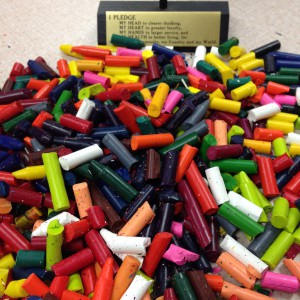
cut crayons
4. Put crayons in silicone baking tray. 230 degrees for 15-20 mins.
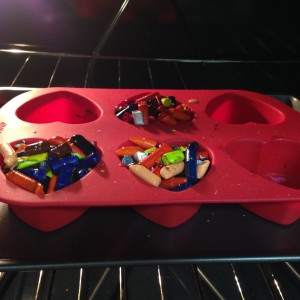
baking crayons
5. Let heart crayons cool and remove (more like peal) from tray.
Now what?
There is so much more to this activity than breaking crayons and melting them into hearts.
- Teamwork is required to prepare all the materials. Don’t forget, crayons won’t peal themselves!
- Planning and organizing are required if youth want to have hearts turn out a certain color. Check out these crayons.
- Decision making is necessary to figure out what will be done with the crayon hearts.
- Should the hearts be donated to a local children’s hospital or Ronald McDonald House?
- Older youth can figure out the per item cost of each heart and compare it to the cost of store-bought gifts.
Whether you need something related to your specific project area or you are seeking an idea for a fun, themed activity, Pinterest will certainly not disappoint. Don’t forget, even if your activity turns into a Pinterest fail, celebrate the teachable moments and successes along the way!
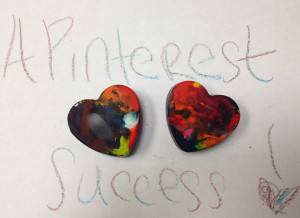
A Pinterest success!
References:
Crayon hearts: https://www.pinterest.com/pin/115334440431430268/
Nifty crayon hearts: https://www.pinterest.com/pin/409898003556943584/
by Whitney Cherry | Feb 6, 2015
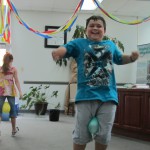
Don’t let the weather ruin your club’s recreational time. Play inside!
It’s that time of year in North Florida when we’re not sure what we’ll wake up to each morning. We may be in short sleeves, sweatshirts, or hip waders and that can make planning a club meeting tough. During this time of year, between the cold and the rain, it’s seldom that our youth are allowed to go outside for PE. And in lower grades, where a gym may not be available, they are often not getting any significant amount of physical activity during the school day. This is neither good for their mental or physical health, so how can we combat the winter-blues in our club meetings? Here are a few suggestions:
Indoor relay and tag games: If space permits, move the furniture out of the way, and let the kids play freeze tag or have a relay race. Relays are often easy to relate to the educational topic of your meeting. Examples include:
- Set the table relay: where youth draw a piece of a table setting out of a paper bag, run to a table across the room, and put it in its proper place on the table. (the floor can be used in place of a table if need be.) The first team to correctly set the table wins.
- Salsa relay: youth put plastic tomatoes or peppers or onions or garlic between their knees and “run/waddle” around a cone, chair, or tape mark, at the other end of the room back to their team where they pass on their piece of food to the next team mate. The first team to have each player complete the task wins.
- Traditional balloon and ring races are always good too.
Exercise bingo: Contact your local extension office for a copy of exercise bingo. In this high intensity game, each youth or team of youth, is given a bingo card and a stack of exercise cards which face down on the floor. A teammate flips an exercise card, and each team member completes the task on the card (arm circles, pushups, jumping jacks, etc.) If their bingo card includes this exercise, the team captain marks that spot off of their card. Teammates take turn flipping exercise cards until they have Bingo. The first team to get Bingo wins.
Simon Says, Duck-Duck-Goose, London Bridge: These games require only a little space, and are still fun for younger youth, especially Cloverbuds (4-7 yrs). Simon says can often relate to your educational program as well. Ex – “Simon says comb your steer.” “Simon says, stir the batter.” “Simon says bait your hook.”
Legos, board games, etc.: It’s not very active, we know, but sometimes space just doesn’t allow for much physical activity, but it’s still important for youth to have time to interact with each other and relax. Be sure not to pick board games that may take hours to complete. Things like Charades, Guestures, Win, Lose or Draw, etc. are great options.
Now it’s your turn. Get creative, and in the comments section below, share with us the ideas you have for indoor recreation!
by Heather Kent | Jan 30, 2015
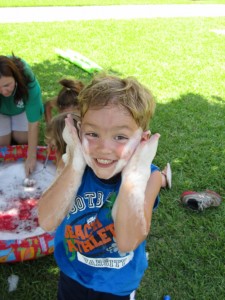 Chances are, if you have ever volunteered with a youth program, you have run into some children who have challenged you with their behavior. Earlier this month, Dr. Kate Fogarty and Sarah Hensley shared some insight and tips for disciplining children in a positive and productive way. The word discipline often has a negative connotation, but the origin of the word is “disciple” which means pupil, student, or apprentice. As a volunteer leader, your role is that of a guide- guiding youth towards acceptable behavior. Discipline, or guidance, is a corrective process to teach youth how to solve their problems rather than punishing them for problems they cannot solve.
Chances are, if you have ever volunteered with a youth program, you have run into some children who have challenged you with their behavior. Earlier this month, Dr. Kate Fogarty and Sarah Hensley shared some insight and tips for disciplining children in a positive and productive way. The word discipline often has a negative connotation, but the origin of the word is “disciple” which means pupil, student, or apprentice. As a volunteer leader, your role is that of a guide- guiding youth towards acceptable behavior. Discipline, or guidance, is a corrective process to teach youth how to solve their problems rather than punishing them for problems they cannot solve.
Here are three tips to remember when working with youth:
- 1. Say “Do” as an alternative to “Don’t.” Examples include:
- “Please use an inside voice during our club meeting. During recreation we will be outside and you can be loud then” instead of “Stop yelling!”
- “Can you tell me what is going on, taking turns?” instead of “Stop fighting!”
- “If you run through the woods, you could get hurt or miss seeing something really interesting” instead of “Don’t run through the woods!”
2 . Use encouragement rather than praise. Encouragement is specific and avoids comparison or competition between youth whereas praise is often vague and can foster competition. Research shows that praise can often lower self-esteem or reduce youth’s motivation for participation in an activity. Here are some examples:
| Praise |
Encouragement |
| I like your photo |
Tell me about your photo… |
| I like the way Jennifer is cleaning up |
I appreciate how Jennifer helped put the art supplies away after the meeting. It really made my job as a leader easier. |
| You did a great job on your demonstration |
How do you feel about your demonstration? |
| You clearly deserved a blue ribbon |
How do you think your record book measured up with the judging standard? |
| You have what it takes to be a great leader |
I have seen so much growth in your leadership skills, especially your ability to make good decisions and solving problems. |
- Set limits and consequences– we set limits to prevent injury to self or others and/or prevent property damage. Limits should be firm, but not strict and should be set with confidence and consistency. The key is following through with the consequences and explaining to the youth how their actions affect others. Examples:
- “If you continue to interrupt our guest speaker, you will have to find a different activity. The other members cannot hear and they want to learn about what horses eat.”
- “If you can’t remember to aim your arrow at the target, you will have to sit out for the next round of shooting. We do not want anyone to get hurt.”
- “If you cannot share, you will lose your turn because everyone wants a chance to play this game just as much as you do.”
Ultimately, the support 4-H volunteers provide youth to develop comes from a sense of safety, belonging, mastery, independence and generosity. There is a UF/IFAS Extension publication from our 4-H Volunteer Training Series on positive discipline for youth http://edis.ifas.ufl.edu/pdffiles/4H/4H34100.pdf. It provides explanations for youth misbehavior (or mistaken behavior) and non-verbal as well as verbal strategies for handling those common issues that come our way working in the field of youth development. To learn more about managing difficult behavior in a positive way, you can view the full, 1-hour workshop online at http://florida4h.org/madmondays.
by Prudence Caskey | Jan 23, 2015

How Will You Make a Difference in 2015?
Let’s all take a big, deep breath…2014 is now a thing of the past! At this moment, we all have to decide what we are going to do in 2015. What will you resolve to do in the New Year? Will you finally use your elliptical for more than just a towel rack? Will you finally finish the book you were reading or that scrapbooking project? There are no limits to what you can accomplish in 2015 and in years to come.
I work with volunteers as the Santa Rosa County 4-H Agent. I know how much time it takes to volunteer and I understand the importance of my volunteers. As a very busy wife, mother, professional, graduate student, Children’s Church director and volunteer, I am often asked how I do it all. The easy answer is prioritize. The long answer is: I make lists, lots of lists! I have shopping lists, to do lists, countdown lists and lists of when my bills are due. Lists for birthdays and anniversaries. My most important list is my goal list. I write down my daily, weekly, monthly and annual goals. I break down my larger goals into smaller goals. I am a firm believer that if we can see it, we can do it!
Whatever you decide to set as a goal for 2015, I encourage you to make a difference. We all have something to offer. At the Extension Office, I meet people every day with something to offer the youth of our county. From those who have a passion for rabbits to those who love to cook and sew. On occasion, men will not offer their expertise, because they think they may not have much to offer. Believe me, showing the young people of our community how to check the oil in their cars, rotate their tires or even build a bookcase, are great life skills to pass on to our youth.
4-H volunteers are essential to help youth make the most of a wide variety of learning experiences. As a volunteer, you can share your personal interests and expertise in a variety of subjects including gardening, shooting sports, robotics, animal science, sewing/crafting, public speaking, foods and nutrition, and much more. In 4-H, you can leverage your experience and skills to help a young person find their own passions and interests.
You decide your level of involvement to fit your schedule:
- Lead youth in a community or project club, afterschool program, camp, or school group
- Serve as a chaperone, board member, judge, or camp counselor
- Develop and support service opportunities for youth to learn caring and compassion in your community
- Work with other volunteers to create fun and exciting programs to help youth in your community reach their full potential
4-H is an opportunity we wish every young person could have because research shows it is a step forward. More than 60 million of our nation’s most successful statesmen, business leaders, and scientists credit 4-H with setting them on a positive, productive path. When you share your experiences with 4-Hers, you make a difference by helping youth become caring and competent citizens. As you make goals for 2015, consider becoming a 4-H volunteer and inspire the next generation.
by Heather Kent | Oct 24, 2014
 Fairs are often the highlight of the 4-H year. From a youth development perspective, fairs provide an opportunity for 4-H members to demonstrate new knowledge, abilities, skills and attitudes. When youth, parents and volunteers work together, fairs are a great way for youth to learn and also be recognized for their efforts. Being properly prepared is key to having a great fair experience.
Fairs are often the highlight of the 4-H year. From a youth development perspective, fairs provide an opportunity for 4-H members to demonstrate new knowledge, abilities, skills and attitudes. When youth, parents and volunteers work together, fairs are a great way for youth to learn and also be recognized for their efforts. Being properly prepared is key to having a great fair experience.
Youth Responsibilities- Establish a realistic timeline to work on your exhibits. Be sure to read the rules and regulations outlined in the 4-H section of the fair book. Pay close attention to deadlines and specific requirements for each project. Make sure that your exhibit is your own work. Exhibits should be in good condition, clean, and labeled with your name, county, and club. Judging score sheets for individual projects can help guide you as you prepare your exhibit.
Parent Responsibilities- Parents can help 4-H members obtain the materials and resources needed to complete 4-H projects, but should never do the project for the youth. Encourage your child to set realistic timelines and goals so that they do not miss entry deadlines. Help them complete their entry form. Many counties offer workshops or clinics in the weeks leading up to fair to help members prepare- take advantage of these sessions!
Volunteer Responsibilities- Share information about fair exhibit categories and deadlines with your 4-H parents. Project leaders are a great resource to help members decide what to exhibit about their project. It could be something they made, or it could be a poster or tabletop display about what they have learned. If possible, assign an older, more experienced member to mentor new members as they prepare.
Consider having a mock judging of exhibits so that any last minute adjustments can be made. Invite parents to attend along with the members and use this meeting as an opportunity to provide feedback and recognition to individual members and to promote club unity and pride.
4-H members are encouraged to try something more challenging each year and to practice good sportsmanship. Exhibiting is designed to be an enjoyable educational experience not just a contest. If you would like to help 4-Hers in your county get ready for the fair, or serve as a judge for your fair, contact your local county Extension Office.








